Quantifying the Effect of Land Use Change Model Coupling
Abstract
1. Introduction
2. Materials and Methods
2.1. Workflow Summary
2.2. The LUC Models GLOBIOM-Brazil and PLUC
2.3. Model Coupling
2.4. Model Comparison
2.5. Model Validation
3. Results
3.1. Initial Land Use Maps
3.2. Validation of Land Use Change in Mato Grosso
3.3. Comparison of Land-Use Change Projections up to 2030
4. Discussion
4.1. Interpretation of the Results
4.2. Limitations and Future Directions
5. Conclusions
Author Contributions
Funding
Acknowledgments
Conflicts of Interest
References
- Prestele, R.; Alexander, P.; Rounsevell, M.D.; Arnet, A.; Calvin, K.; Doelman, J.; Eitelberg, D.; Engström, K.; Fujimori, S.; Hasegawa, N.; et al. Hotspots of uncertainty in land-use and land-cover change projections: A global-scale model comparison. Glob. Change Biol. 2016, 22, 3967–3983. [Google Scholar] [CrossRef] [PubMed]
- Ahammad, H.; Clark, H.; Dong, H.; Elsiddig, E.; Haberl, H.; Harper, R.; House, J.; Jafari, M.; Masera, O.; Mbow, C.; et al. Agriculture, forestry and other land use (AFOLU). In Climate Change 2014: Mitigation of Climate Change. Contribution of Working Group III to the Fifth Assessment Report of the Intergovernmental Panel on Climate Change; Edenhofer, O., R. Pichs-Madruga, Y., Sokona, E., Farahani, S., Kadner, K., Seyboth, A., Adler, I., Baum, S., Brunner, P., Eickemeier, B., et al., Eds.; Cambridge University Press: Cambridge, UK; New York, NY, USA, 2014. [Google Scholar]
- Tubiello, F.N.; Salvatore, M.; Ferrara, A.F.; House, J.; Federici, S.; Rossi, S.; Biancalani, R.; Golec, R.D.; Federici, S.; Jacobs, H.; et al. The contribution of agriculture, forestry and other land use activities to global warming, 1990–2012. Glob. Change Biol. 2015, 21, 2655–2660. [Google Scholar] [CrossRef] [PubMed]
- Schaldach, R.; Alcamo, J.; Koch, J.; Kölking, C.; Lapola, D.M.; Schüngel, J.; Priess, J.A. An integrated approach to modelling land-use change on continental and global scales. Environ. Model. Softw. 2011, 26, 1041–1051. [Google Scholar] [CrossRef]
- Pitman, A.J.; de Noblet-Ducoudré, N.; Cruz, F.T.; Davin, E.L.; Bonan, G.B.; Brovkin, V.; Claussen, M.; Delire, C.; Ganzeveld, L.; Gayler, V.; et al. Uncertainties in climate responses to past land cover change: First results from the LUCID intercomparison study. Geophys. Res. Lett. 2009, 36. [Google Scholar] [CrossRef]
- De Noblet-Ducoudré, N.; Boisier, J.; Pitman, A.; Bonan, G.B.; Brovkin, V.; Cruz, F.; Delire, C.; Gayler, V.; van den Hurk, B.J.J.M.; Lawrence, P.J.; et al. Determining robust impacts of land-use-induced land cover changes on surface climate over North America and Eurasia: results from the first set of LUCID experiments. J. Clim. 2012, 25, 3261–3281. [Google Scholar] [CrossRef]
- Lambin, E.F.; Geist, H.J. (Eds.) Land-use and land-cover Change: Local Processes and Global Impacts; Springer-Verlag: Berlin/Heidelberg, Germany, 2008; ISBN-10: 3-540-32201-9. [Google Scholar]
- Guo, L.B.; Gifford, R.M. Soil carbon stocks and land use change: A meta analysis. Glob. Change Biol. 2002, 8, 345–360. [Google Scholar] [CrossRef]
- MacCracken, M. Prediction versus Projection–Forecast versus possibility. WeatherZine 2001, 26. Available online: https://sciencepolicy.colorado.edu/zine/archives/1-29/26/guest.html (accessed on 7 February 2020).
- Wicke, B.; Hilst, F.; Daioglou, V.; Banse, M.; Beringer, T.; Gerssen-Gondelach, S.; Heijnen, S.; Karssenberg, D.; Laborde, D.; Lippe, M.; et al. Model collaboration for the improved assessment of biomass supply, demand, and impacts. Glob. Change Biol. Bioenerg. 2015, 7, 422–437. [Google Scholar] [CrossRef]
- Robinson, D.T.; Di Vittorio, A.; Alexander, P.; Arneth, A.; Barton, C.M.; Brown, D.G.; Kettner, A.; Lemmen, C.; O’Neill, B.C.; Janssen, M.; et al. Modelling feedbacks between human and natural processes in the land system. Earth Syst Dyn. 2018, 9, 895–914. [Google Scholar] [CrossRef]
- Alexander, P.; Prestele, R.; Verburg, P.H.; Arneth, A.; Baranzelli, C.; Batista e Silva, F.; Brown, C.; Butler, A.; Calvin, K.; Dendoncker, N.; et al. Assessing uncertainties in land cover projections. Glob. Change Biol. 2017, 23, 767–781. [Google Scholar] [CrossRef]
- Lapola, D.M.; Schaldach, R.; Alcamo, J.; Bondeau, A.; Koch, J.; Koelking, C.; Priess, J.A. Indirect land-use changes can overcome carbon savings from biofuels in Brazil. Proc. Natl. Acad. Sci. 2010, 107, 3388–3393. [Google Scholar] [CrossRef]
- Verstegen, J.A.; Hilst, F.; Woltjer, G.; Karssenberg, D.; Jong, S.M.; Faaij, A.P. What can and can’t we say about indirect land-use change in Brazil using an integrated economic–land-use change model? Glob. Change Biol. Bioenerg. 2016, 8, 561–578. [Google Scholar] [CrossRef]
- Meiyappan, P.; Dalton, M.; O’Neill, B.C.; Jain, A.K. Spatial modeling of agricultural land use change at global scale. Ecol. Model. 2014, 291, 152–174. [Google Scholar] [CrossRef]
- Halofsky, J.E.; Hemstrom, M.A.; Conklin, D.R.; Halofsky, J.S.; Kerns, B.K.; Bachelet, D. Assessing potential climate change effects on vegetation using a linked model approach. Ecol. Model. 2013, 266, 131–143. [Google Scholar] [CrossRef]
- Soterroni, A.; Mosnier, A.; Carvalho, A.X.; Câmara, G.; Obersteiner, M.; Andrade, P.R.; Souza, R.; Brock, R.; Pirker, J.; Kraxner, F.; et al. Future environmental and agricultural impacts of Brazil’s Forest Code. Environ. Res. Lett. 2018, 13, 074021. [Google Scholar] [CrossRef]
- Buurman, M.; Câmara, G.; Carvalho, A.; Jones, J.; Cartaxo, R.; Mosnier, A.; Pirker, J.; Andrade, P.; Affonso, A.; Soterroni, A.; et al. Description of the GLOBIOM-BRAZIL database available in the REDD-PAC WFS server 2015. Available online: http://pure.iiasa.ac.at/id/eprint/13742/1/wfs_globiom_brazil_1April2015.pdf (accessed on 7 February 2020).
- Câmara, G.; Soterroni, A.; Ramos, F.; Cartaxo, R.; Buurman, M.; Affonso, A.; Espindola, G.; Carvalho, A.; Marina, P.; Andrade, P.; et al. Modelling Land Use Change in Brazil: 2000–2050. São José dos Campos, Brasília, Laxenburg, Cambridge. INPE, IPEA, IIASA, UNEP-WCMC 2015, 1st edition. Available online: https://epic.awi.de/id/eprint/41900/1/lucbrazil.pdf (accessed on 7 February 2020).
- Verstegen, J.A.; Karssenberg, D.; van der Hilst, F.; Faaij, A. Spatio-temporal uncertainty in Spatial Decision Support Systems: A case study of changing land availability for bioenergy crops in Mozambique. Comput. Environ. Urban Syst. 2012, 36, 30–42. [Google Scholar] [CrossRef]
- Picoli, M.; Câmara, G.; Sanches, I.; Simões, R.; Carvalho, A.; Maciel, A.; Coutinho, A.; Esquerdo, J.; Antunes, J.; Begotti, R.; et al. Big Earth Observation Time Series Analysis for Monitoring Brazilian Agriculture. ISPRS J. Photogramm. Remote Sens. 2018. [Google Scholar] [CrossRef]
- OECD/Food and Agriculture Organization of the United Nations. OECD-FAO Agricultural Outlook 2014; OECD Publishing: Paris, France, 2014. [Google Scholar]
- Dias, L.C.; Pimenta, F.M.; Santos, A.B.; Costa, M.H.; Ladle, R.J. Patterns of land use, extensification, and intensification of Brazilian agriculture. Glob. Change Biol. 2016, 22, 2887–2903. [Google Scholar] [CrossRef]
- De Rosa, M.; Knudsen, M.T.; Hermansen, J.E. A comparison of Land Use Change models: challenges and future developments. J. Clean. Prod. 2016, 113, 183–193. [Google Scholar] [CrossRef]
- Sparovek, G.; Berndes, G.; Klug, I.L.; Barretto, A.G. Brazilian agriculture and environmental legislation: Status and future challenges. Environ. Sci. Tech. 2010, 6046–6053. [Google Scholar] [CrossRef]
- Strassburg, B.; Latawiec, A.; Barioni, L.; Nobre, C.A.; Silva, V.P.; Valentim, J.F.; Vianna, M.; Assade, E.D. When enough should be enough: Improving the use of current agricultural lands could meet production demands and spare natural habitats in Brazil. Glob. Environ. Chang. 2014, 28, 84–97. [Google Scholar] [CrossRef]
- Câmara, G.; Picoli, M.; Simoes, R.; Maciel, A.; Carvalho, A.; Coutinho, A.; Esquerdo, J.; Antunes, J.; Begotti, R.; Arvor, D. Land cover change maps for Mato Grosso State in Brazil: 2001–2016, links to files 2017; PANGAEA: Bremen, Germany, 2017. [Google Scholar] [CrossRef]
- Moriasi, D.N.; Arnold, J.G.; Van Liew, M.W.; Bingner, R.L.; Harmel, R.D.; Veith, T.L. Model Evaluation Guidelines for Systematic Quantification of Accuracy in Watershed Simulations. Trans. ASABE 2007, 50, 885–900. [Google Scholar] [CrossRef]
- Havlík, P.; Schneider, U.A.; Schmid, E.; Böttcher, H.; Fritz, S.; Skalský, R.; Aoki, K.; De Cara, S.; Kindermann, G.; Kraxner, F.; et al. Global land-use implications of first and second generation biofuel targets. Energy Policy 2011, 39, 5690–5702. [Google Scholar] [CrossRef]
- Gibbs, H.K.; Rausch, L.; Munger, J.; Schelly, I.; Morton, D.C.; Noojipady, P.; Soares-Filho, B.; Barreto, P.; Micol, L.; Walker, N.F. Brazil’s soy moratorium. Science 2015, 347, 377–378. [Google Scholar] [CrossRef] [PubMed]
- Van der Hilst, F.; Verstegen, J.A.; Zheliezna, T.; Drozdova, O.; Faaij, A.P.C. Integrated spatiotemporal modelling of bioenergy production potentials, agricultural land use, and related GHG balances; demonstrated for Ukraine. Biofuels, Bioproducts and Biorefining 2014, 8, 391–411. [Google Scholar] [CrossRef]
- Van der Hilst, F.; Verstegen, J.A.; Woltjer, G.; Smeets, E.M.; Faaij, A.P.C. Mapping land use changes resulting from biofuel production and the effect of mitigation measures. Glob. Change Biol. Bioenerg. 2018, 10, 804–824. [Google Scholar] [CrossRef]
- O’Neill, B.C.; Kriegler, E.; Riahi, K.; Ebi, K.L.; Hallegatte, S.; Carter, T.R.; Mathur, R.; van Vuuren, D.P.A. New scenario framework for climate change research: The concept of shared socioeconomic pathways. Clim. Chang. 2014, 122, 387–400. [Google Scholar] [CrossRef]
- Soterroni, A.; Mosnier, A.; Carvalho, A.X.; Câmara, G.; Obersteiner, M.; Andrade, P.R.; Souza, R.; Brock, R.; Pirker, J.; Kraxner, F.; et al. Future environmental and agricultural impacts of Brazil’s Forest Code, links to files in ArcGIS shapefile format; PANGAEA: Bremen, Germany, 2018. [Google Scholar] [CrossRef]
- van Vliet, J.; Bregt, A.K.; Hagen-Zanker, A. Revisiting Kappa to account for change in the accuracy assessment of land-use change models. Eco. Model. 2011, 222, 367–1375. [Google Scholar] [CrossRef]
- Pontius, R.G., Jr.; Cheuk, M.L. A generalized cross-tabulation matrix to compare soft-classified maps at multiple resolutions. Int. J. Geogr. Inf. Sci. 2006, 20, 1–30. [Google Scholar] [CrossRef]
- IBGE. Censo Agropecuário 2006, Fundação Instituto Brasileiro de Geografia e Estatística 2006. Available online: http://www.sidra.ibge.gov.br (accessed on 7 February 2020).
- Gasques, J.; Bastos, E.; Valdes, C.; Bacchi, M. Produtividade e crescimento - algumas comparacoes; Technical report; IPEA (Institute of Applied Economic Research): Brasília, Brazil, 2012.
- Verstegen, J.A.; van der Laan, C.; Dekker, S.C.; Faaij, A.P.C.; Santos, M.J. Recent and projected impacts of land use and land cover changes on carbon stocks and biodiversity in East Kalimantan. Indonesia. Eco. Indicators 2019, 103, 563–575. [Google Scholar] [CrossRef]
- Chen, Y.; Bakker, M.M.; Ligtenberg, A.; Bregt, A.K. How Are Feedbacks Represented in Land Models? Land 2016, 5, 29. [Google Scholar] [CrossRef]
- Verstegen, J.A.; Karssenberg, D.J.; van der Hilst, F.; Faaij, A.P.C. Identifying a land use change cellular automaton by Bayesian data assimilation. Environ. Model. Softw. 2014, 53, 121–136. [Google Scholar] [CrossRef]
- Parente, L.; Mesquita, V.; Miziara, F.; Baumann, L.; Ferreira, L. Assessing the pasturelands and livestock dynamics in Brazil, from 1985 to 2017: A novel approach based on high spatial resolution imagery and Google Earth Engine cloud computing. Remote Sens. Environ. 2019, 232. [Google Scholar] [CrossRef]
- Pontius, R.G., Jr.; Schneider, L.C. Land-cover change model validation by an ROC method for the Ipswitch watershed, Massachusetts, USA. Agric. Ecosyst. Environ. 2001, 85, 239–248. [Google Scholar] [CrossRef]
- Van Delden, H.; van Vliet, J.; Rutledge, D.T.; Kirkby, M.J. Comparison of scale and scaling issues in integrated land-use models for policy support. Agric. Ecosyst. Environ. 2011, 142, 18–28. [Google Scholar] [CrossRef]
| 1 | Whereas a prediction assumes that future changes in a system’s conditions will not influence the future system state, a projection specifically accounts for changes in the conditions [9]. The sets of possible conditions are then typically captured in scenarios. As such, a weather model makes predictions but a LUC model or climate model makes projections. |
| 2 | The classification is in fact a mix of land use and land cover classes, but for simplicity we refer to them as land use classes throughout this paper. |
| 3 | LU derived from remote sensing is not directly observed. Reflectance is observed by the sensor and this reflectance is translated into land use. Therefore, technically, the time series of LU maps are a modelled variable too. However, in the context of our work, the time series of LU maps represent the independent land use situation to which we compared our model results; therefore, we refer to them as ‘observations’. |
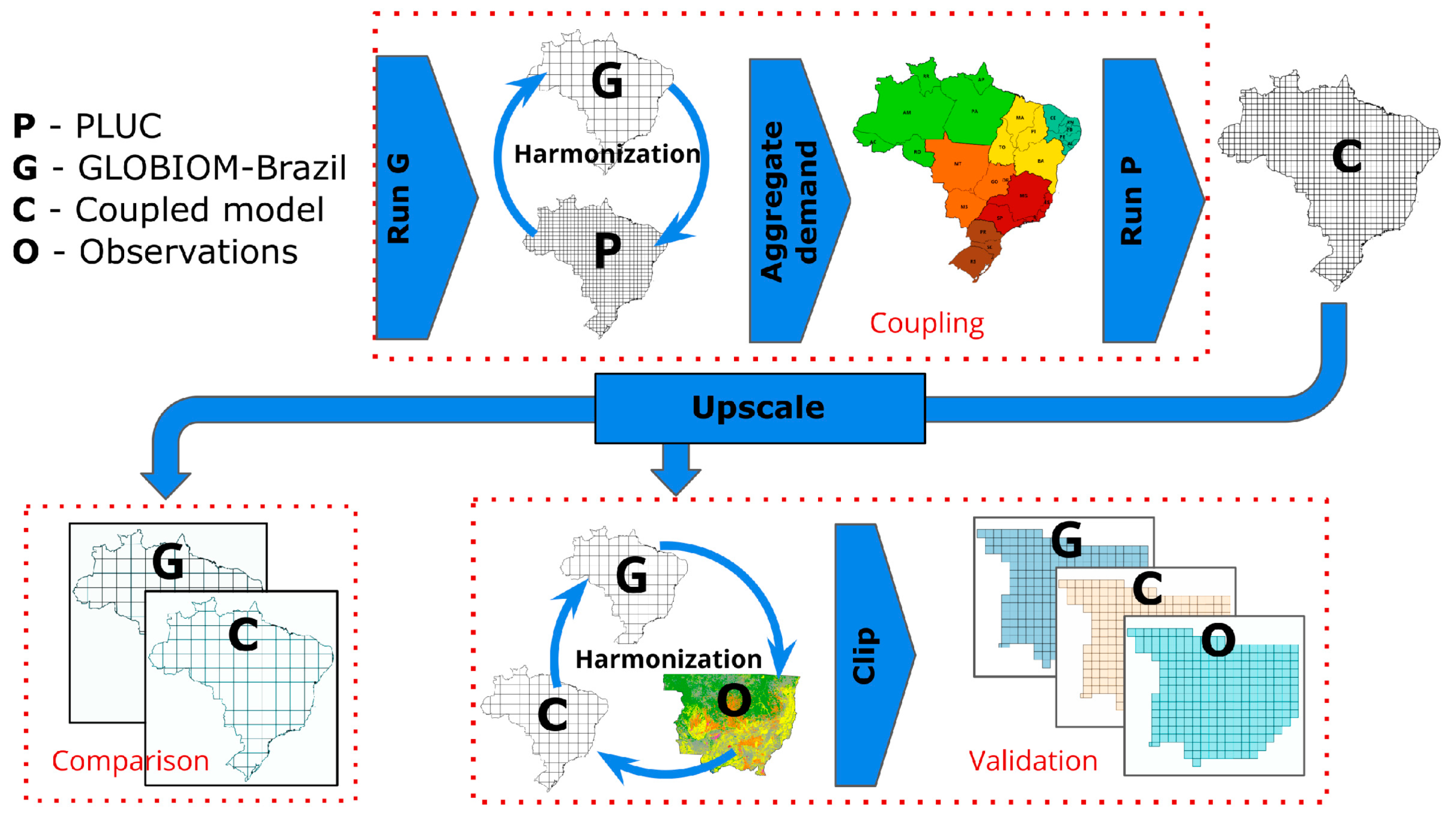

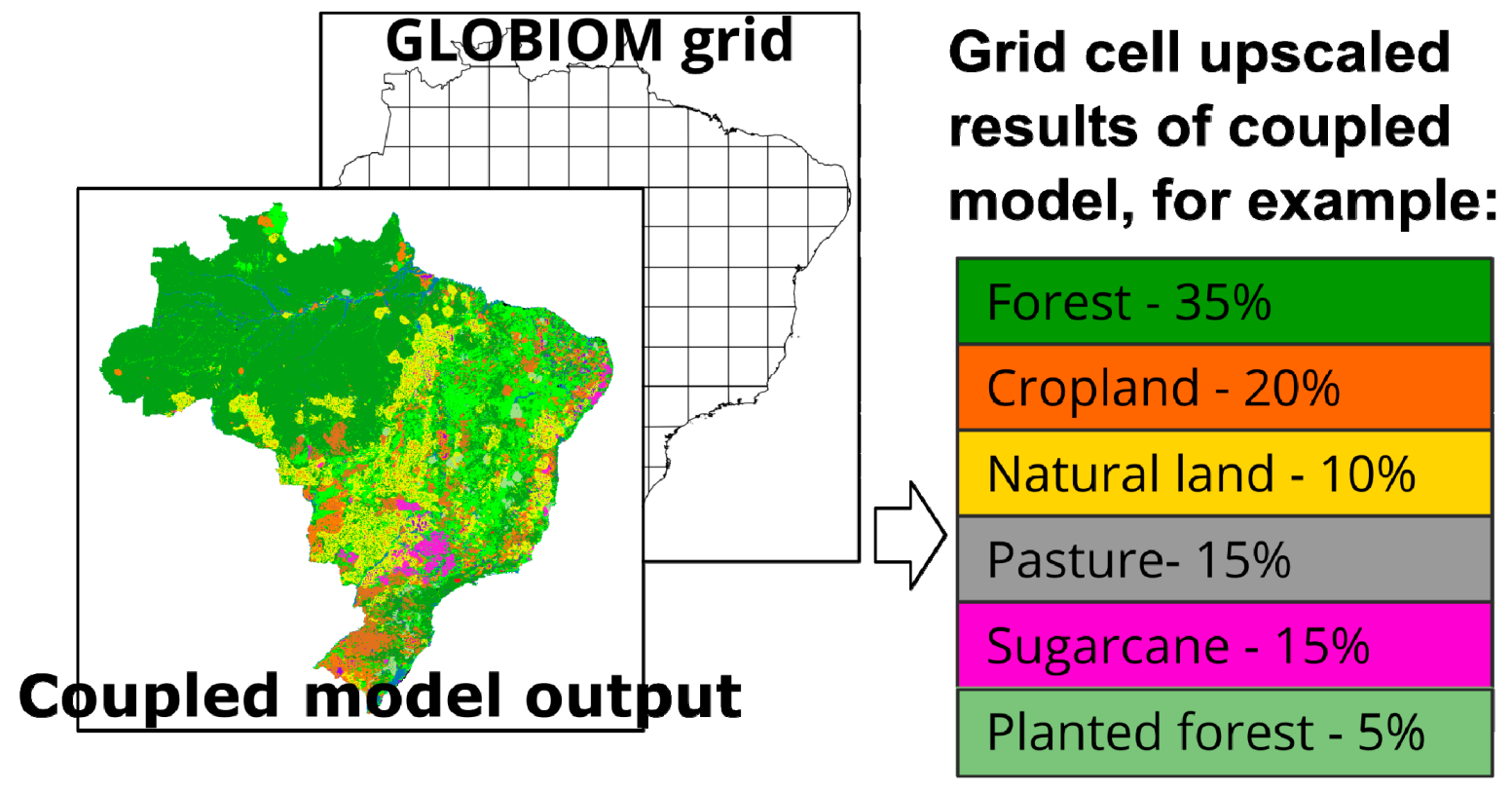
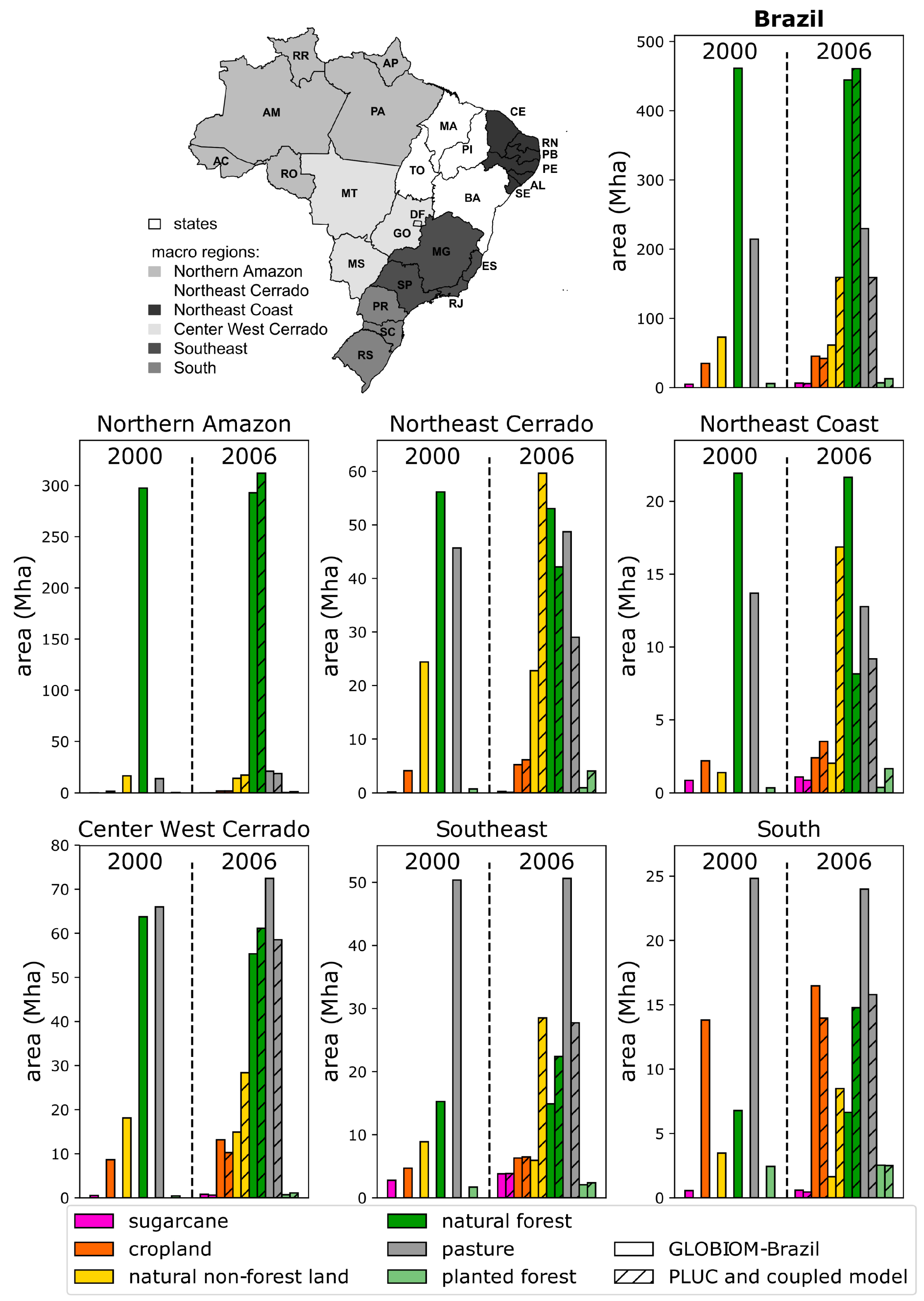
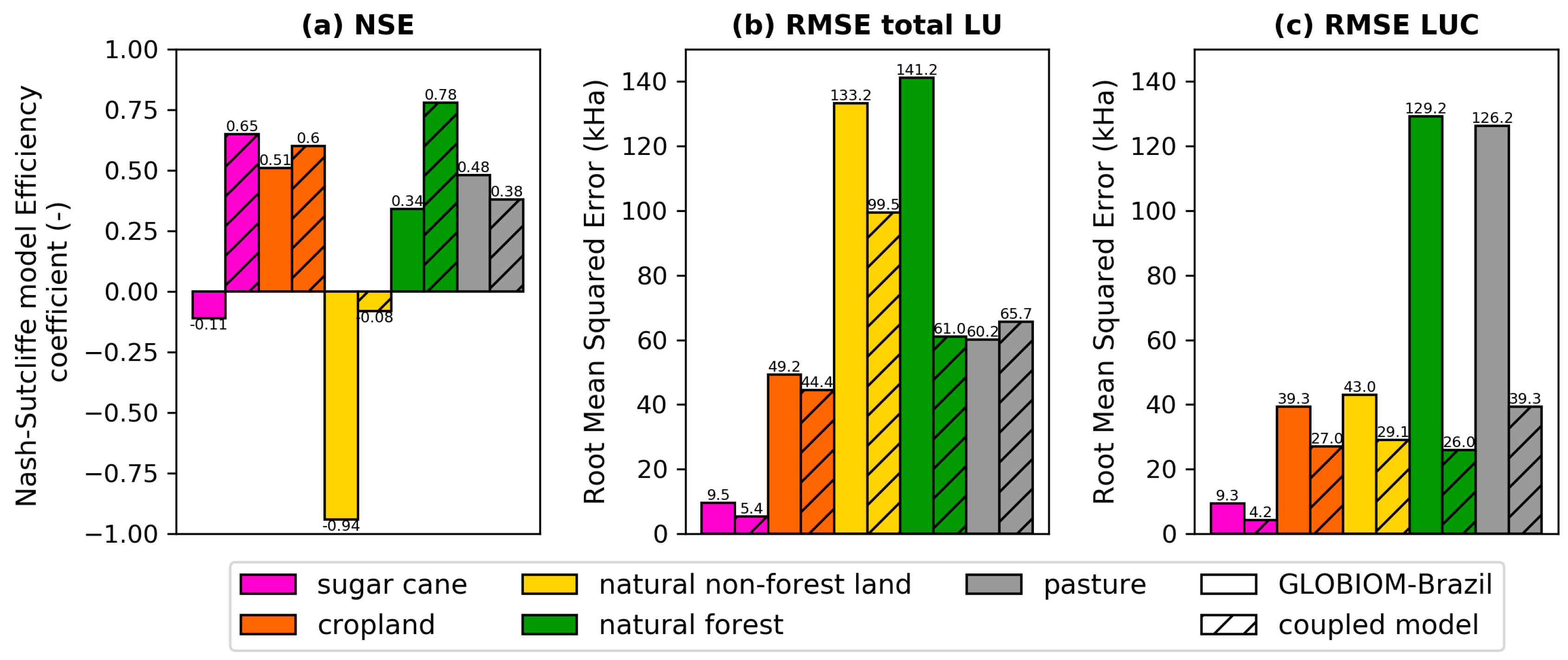
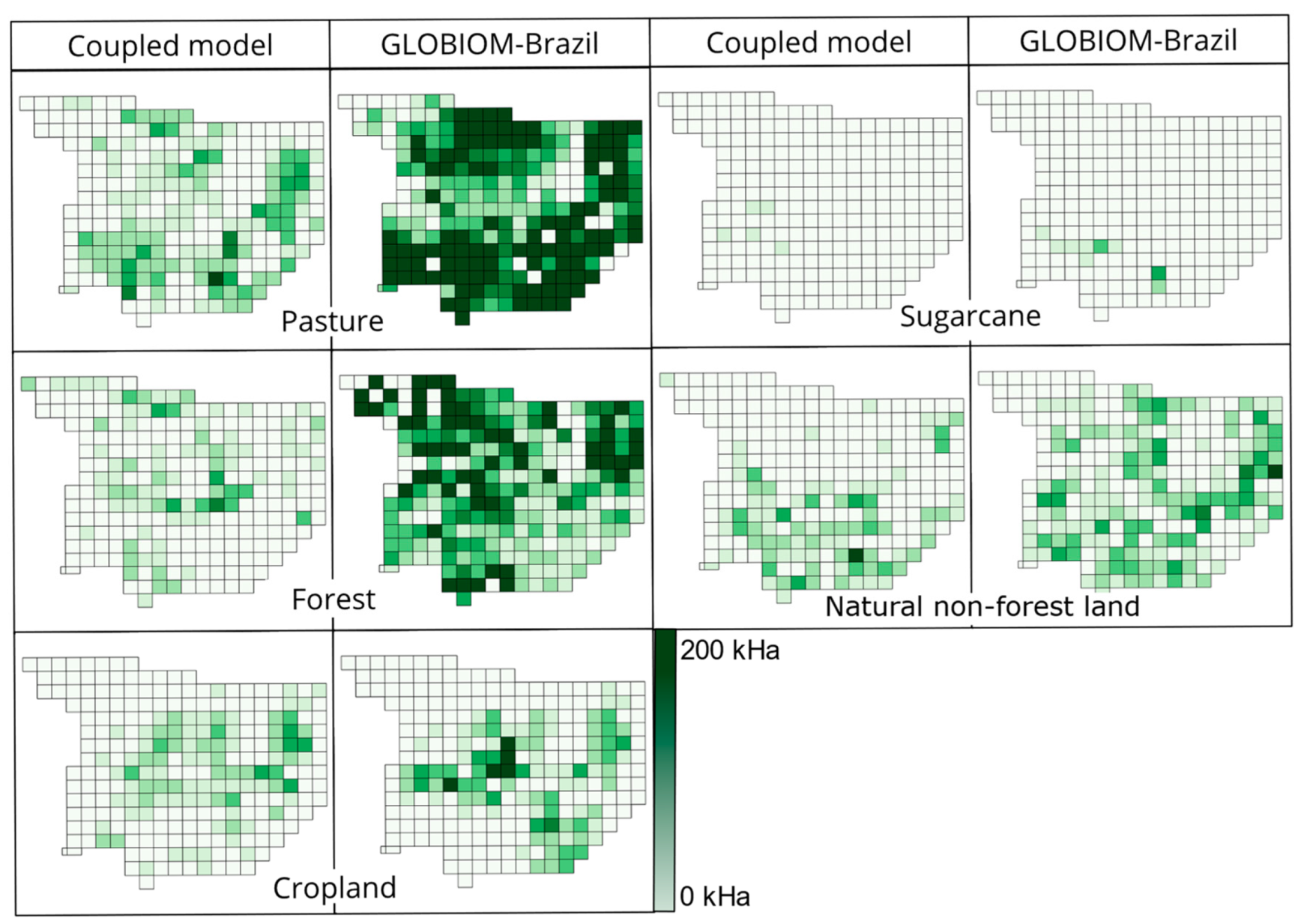
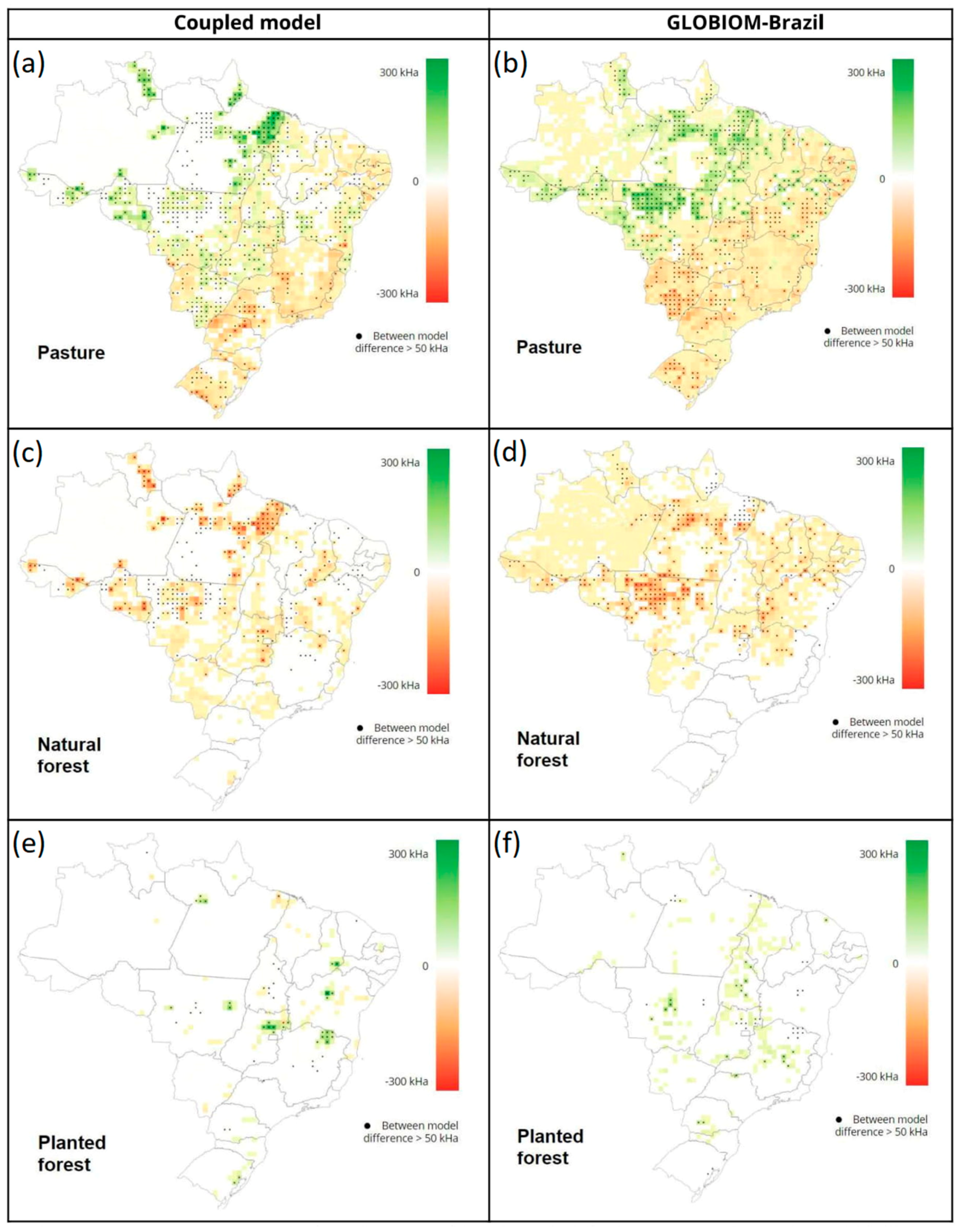
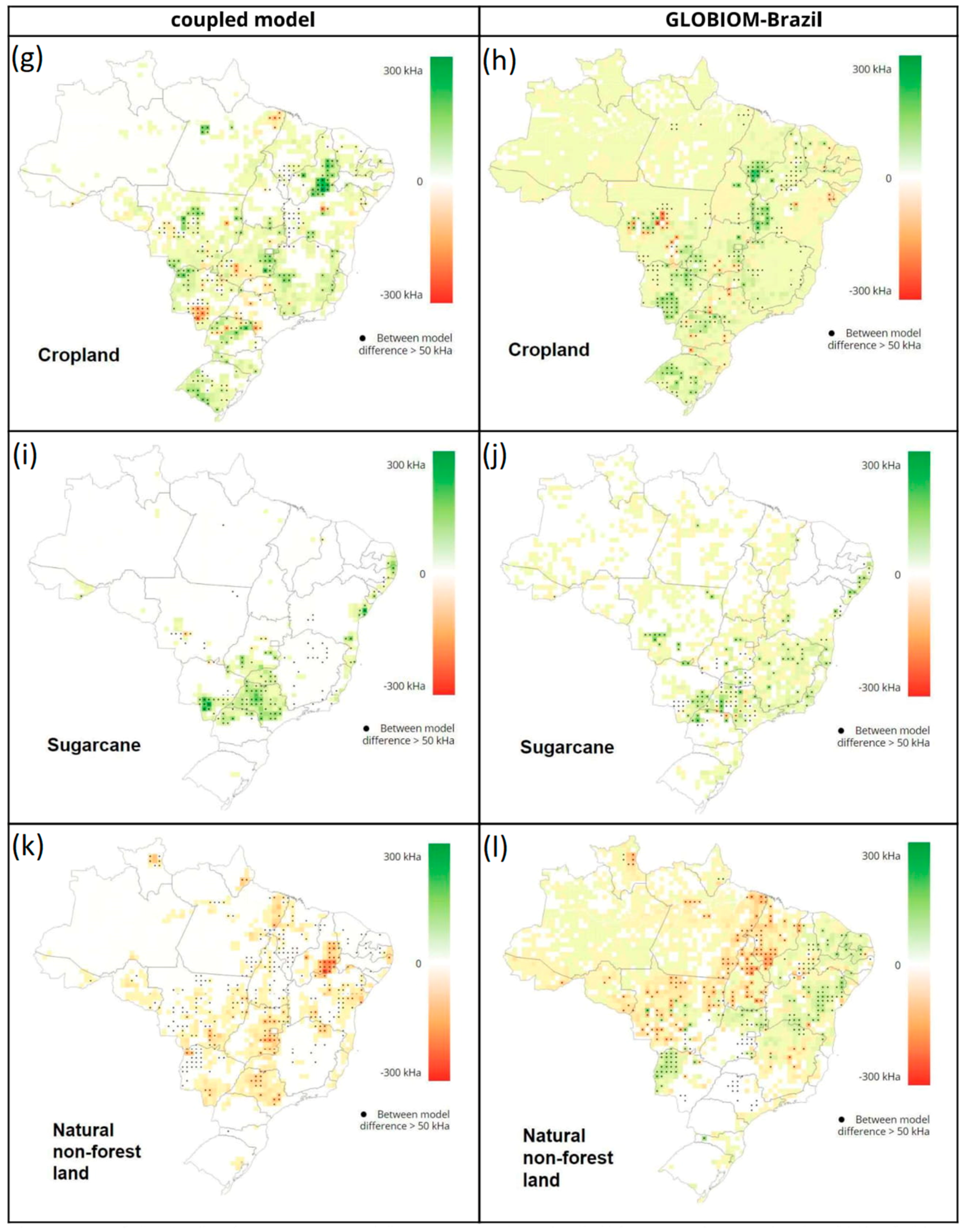
| GLOBIOM-Brazil | PLUC | Coupled Model | Observational Data | Validation |
|---|---|---|---|---|
| Cropland * | Cropland | Cropland Δ | Cropland *** | Cropland |
| Sugarcane | Sugarcane Δ | Sugarcane | Sugarcane | |
| Grassland | Rangeland | Pasture**Δ | Pasture | Pasture |
| Planted pasture | ||||
| Planted forest | Planted forest | Planted forest Δ | Forest | Forest |
| Managed forest | Natural forest | Natural forest | ||
| Forest regrowth | ||||
| Mature forest | ||||
| Natural land | Grass and shrubs | Natural non-forest land | Cerrado | Natural non-forest land |
| GLOBIOM-Brazil | PLUC | |
|---|---|---|
| Modeling paradigm | partial equilibrium (PE) model | demand-driven model |
| Demand for land in Brazil | endogenous | exogenous per macro region |
| Allocation of land classes | optimization with linear programming | fixed order, calibrated |
| Forest protection in land allocation | illegal deforestation possible, Forest Code enforced in Amazon only | protected areas and indigenous reserves excluded from expansion |
| Spatial resolution of finest scale | 0.5 by 0.5 decimal degrees | 5 kilometer by 5 kilometer |
| Temporal resolution | 10 years | 1 year |
| Data type of output maps | scalar | nominal |
| Land-use classes in output maps | see Table 1 | |
| observations | ||||||||
|---|---|---|---|---|---|---|---|---|
| sugarcane | cropland | natural non-forest land | forest | pasture | other | total | ||
| GLOBIOM-Brazil | sugarcane | 0.20% | 0.09% | 0.45% | 0.10% | 0.00% | 0.00% | 0.84% |
| cropland | 0.07% | 7.55% | 2.27% | 1.13% | 0.33% | 0.03% | 11.38% | |
| natural non-forest land | 0.00% | 0.64% | 6.51% | 0.67% | 0.10% | 0.02% | 7.95% | |
| forest | 0.01% | 0.66% | 4.35% | 22.87% | 0.68% | 0.02% | 28.59% | |
| pasture | 0.03% | 1.74% | 8.07% | 6.28% | 25.43% | 0.03% | 41.58% | |
| other | 0.02% | 0.78% | 4.60% | 2.78% | 0.32% | 1.17% | 9.66% | |
| total | 0.33% | 11.46% | 26.24% | 33.83% | 26.87% | 1.27% | 100.00% | |
| observations | ||||||||
|---|---|---|---|---|---|---|---|---|
| sugarcane | cropland | natural non-forest land | forest | pasture | other | total | ||
| coupled model | Sugarcane | 0.25% | 0.11% | 0.12% | 0.01% | 0.07% | 0.00% | 0.56% |
| Cropland | 0.02% | 7.00% | 1.21% | 0.42% | 0.84% | 0.03% | 9.52% | |
| natural non-forest land | 0.00% | 0.47% | 12.90% | 0.10% | 0.58% | 0.04% | 14.10% | |
| Forest | 0.02% | 2.38% | 6.18% | 32.14% | 4.29% | 0.10% | 45.12% | |
| Pasture | 0.03% | 0.81% | 3.59% | 0.68% | 19.74% | 0.07% | 24.91% | |
| Other | 0.01% | 0.68% | 2.24% | 0.49% | 1.35% | 1.03% | 5.80% | |
| Total | 0.33% | 11.46% | 26.24% | 33.83% | 26.87% | 1.27% | 100.00% | |
© 2020 by the authors. Licensee MDPI, Basel, Switzerland. This article is an open access article distributed under the terms and conditions of the Creative Commons Attribution (CC BY) license (http://creativecommons.org/licenses/by/4.0/).
Share and Cite
Stepanov, O.; Câmara, G.; Verstegen, J.A. Quantifying the Effect of Land Use Change Model Coupling. Land 2020, 9, 52. https://doi.org/10.3390/land9020052
Stepanov O, Câmara G, Verstegen JA. Quantifying the Effect of Land Use Change Model Coupling. Land. 2020; 9(2):52. https://doi.org/10.3390/land9020052
Chicago/Turabian StyleStepanov, Oleg, Gilberto Câmara, and Judith A. Verstegen. 2020. "Quantifying the Effect of Land Use Change Model Coupling" Land 9, no. 2: 52. https://doi.org/10.3390/land9020052
APA StyleStepanov, O., Câmara, G., & Verstegen, J. A. (2020). Quantifying the Effect of Land Use Change Model Coupling. Land, 9(2), 52. https://doi.org/10.3390/land9020052






